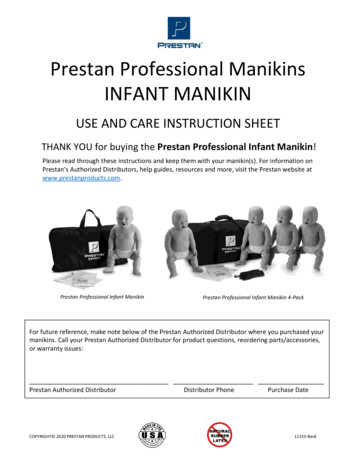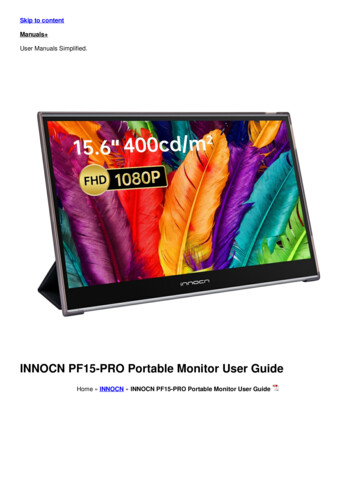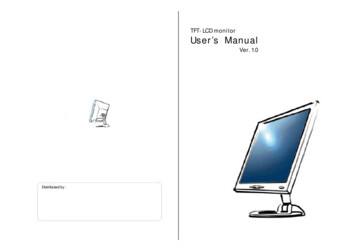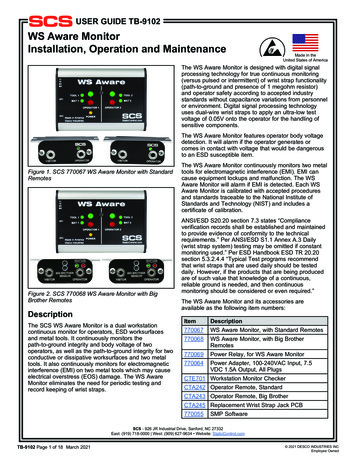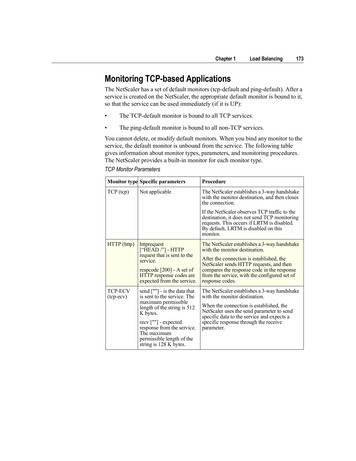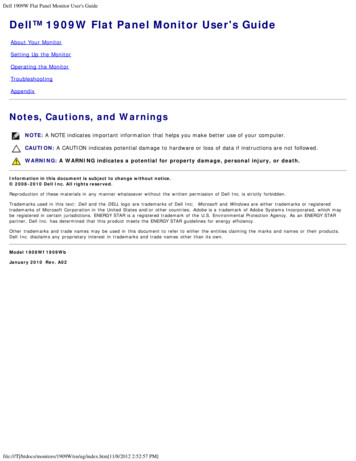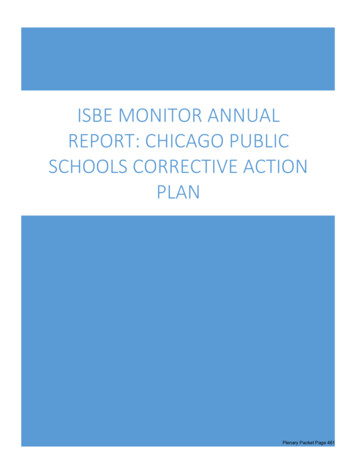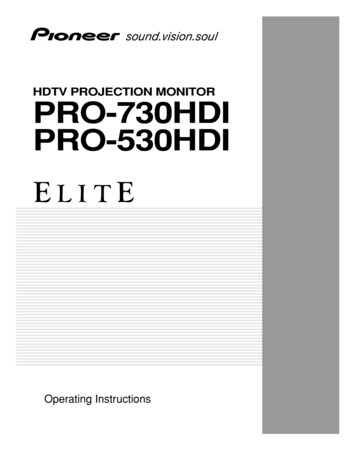
Transcription
FARM-D LIVE TALKSGENDER AND CLIMATE RISK FINANCELIVE TALK 02Demonstrating Impact: How to monitor and evaluategender-responsive Climate and Disaster Risk Finance andInsurance (CDRFI)?WEBINAR REPLAY!October 2020Following Live Talk 01 on Integrating Gender-responsive Strategies into Climate and Disaster Risk Finance and InsuranceSolutions, the InsuResilience Global Partnership in collaboration with the Forum for Agricultural Risk Management inDevelopment (FARM-D), organised a second Live Talk on 14 October 2020 as part of the Live Talk Series on “Gender and ClimateRisk Finance”. The objective of this second Live Talk was to deep dive into the recommendations from the study commissionedby the InsuResilience Secretariat, “Integrating Gender Considerations into Different Models of Climate Risk Insurance (CRI)”.1. BackgroundGender-responsive Climate and Disaster Risk Finance and Insurance (CDRFI) seeks to provide financial protection that addressesdifferences in women and men’s vulnerability to both climate and disaster-induced losses and damages on an economic andsocial level. The InsuResilience Global Partnership (the Partnership) Gender Working Group has identified a lack of sufficientsex-disaggregated data used by clients, staff and members, and a lack of data on the gender differential impacts of CDRFIcoverage and payouts of existing solutions. Similarly, the collection and analysis of information on financial literacy, access totraining and the use of insurance products and services by vulnerable men and women in rural areas is insufficient.Furthermore, the Working Group notes that the comprehensive guidance to support the effective monitoring and evaluationof the differentiated impact on women and men of such schemes is largely missing and there is little documentation ofexisting examples of good practice. Thus, despite a clear commitment from donors and implementing partners to create moregender-responsive CDRFI, there is also a recognized knowledge gap in how gender-responsive M&E could both demonstrateand improve the impact of solutions that address gender-specific differences in vulnerability.As such, there is an opportunity for members of the Partnership and the wider CDRFI community to share examples ofexisting gender-responsive approaches in M&E of CDRFI activities, as well as challenges and opportunities to improvemeasurement of gender impacts at different phases of the programme cycle in the implementation of CDRFI. Further, thereare very specific gender considerations needed at diverse phases of the data collection process.
// LIVE TALK 02These range from setting baselines, the design of indicators, methodologies for data collection and ongoing measurements, toanalysing and using M&E outputs to enhance the gender-responsiveness of solutions and to clearly demonstrate impact forall groups of people.Only through a comprehensive and gender-responsive approach to monitoring the performance (during implementation)and evaluating results (during implementation and after closing) of CDRFI interventions would diverse stakeholders be able tounderstand whether the actions taken are effectively responding to differences in vulnerabilities between sexes and are havingthe intended impact.2. Speakers and moderatorsLeona AbbanCountry Manager,MicroEnsure, GhanaEmily ColemanAgricultural Insurance Technical Lead,INSURED / PARM, International Fundfor Agricultural Development (IFAD)Andrew HobbsAssistant Professor,University of San FranciscoAnita BarewalDeputy Director,International Climate Finance Policyand Governance, Global Affairs CanadaToby BehrmannInnovation and Partnerships Lead,Global ParametricsMedhin Fissha MekonnenGender and Safeguards Specialist,CRGE Facility, Ministry of Finance andEconomic Cooperation EthiopiaSven HarmelingGlobal Policy Lead,Climate Change and ResilienceCARE InternationalKatherine MilesGender Consultant,InsuResilience SecretariatVositha WijenayakeExecutive Director and Director,Adaptation and Resilience ProgrammeSLYCAN Trust, Sri Lanka
3. ParticipantsThe Live Talk hosted a total of 110 participants. Two panel discussions focused on existing gender-responsive approachesin monitoring and evaluation of CDRFI activities, as well as challenges and opportunities to improve measurement of genderimpacts at different phases of the programme cycle in the implementation of CDRFI, respectively.Box 1Participants at a GlanceFig. 1 - Participants by type of organization7%Fig. 2 - Participants by geographical region11%18%24%Academia / Research22%Asia & the PacificDevelopment / Multilateral AgencyEuropeFarmers OrganizationLatin America & and CaribbeanFreelance / IndependentMiddle East & North Africa17%GovernmentNorth AmericaNon-Profit OrganizationSub-Saharan AfricaPrivate Sector39%4%16%37%5%4. Objectives and structure of the webinarFollowing the Live Talk on “Integrating gender-responsive strategies into climate and disaster risk finance and insurancesolutions” which laid the foundation for further deep dive discussions, this interactive Live Talk focused on the followingobjectives: Identify existing approaches, challenges and opportunities for the monitoring and evaluation of gender responsive CDRFIat different stages of project cycles; Gather input for the development of practitioner-driven guidance on designing indicators, collecting and analysing sexdisaggregated gender data in order to determine and increase positive gender impacts of solutions and to distil principlesand criteria useful for M&E; Inform the creation of a guidance note, commissioned by the InsuResilience Gender Working Group, on how to incorporategender-responsive dimensions within monitoring and evaluation processes, which could be used by members of thePartnership and the broader CDRFI network.Box 2Plenary Poll 1**based on participants answers1. Do you regard any of the CDRFI schemesyou are involved in as gender-responsive?2. Do you think existing approaches to theM&E of CDRFI scheme are gender-responsive?3. Are you involved in the M&E of aCDRFI 9%NoUnsure38%33%// Page 3
// LIVE TALK 02Box 3Live Talk 02 AgendaOpening RemarksSESSION 1 - PlenaryGender-responsive M&E of CDRFI schemes: Whatdoes “good” look like in the design and implementation of schemes?SESSION 2 - Breakout GroupsMeasuring the gender impact of CDRFI schemesand payoutsClosing Remarks and Way ForwardAnita BarewalModerator: Katherine MilesPanelists:Toby BehrmannMedhin Fissha MekonnenVositha WijenayakeModerator: Emily ColemanPanelists:Sven HarmelingLeona AbbanAndrew HobbsAnita BarewalOPENING REMARKSSpeaker: Anita Barewal, Global Affairs Canada and Co-chair to the InsuResilience Gender Working GroupThe Live Talk was opened with remarks from Anita Barewal, Co-chair of the Gender Working Group and the Deputy Director ofInternational Climate Finance Policy and Governance at Global Affairs Canada. She set the scene with the recent endorsementof the InsuResilience Declaration on Gender by the High-level Consultative Group (HLCG), the highest governing body of theInsuResilience Global Partnership. The Declaration on Gender provides a broad action plan that the Partnership memberscan aspire to in order to support the promotion of gender equality, equity and enhance gender-responsiveness within theiractivities. The declaration provides a framework for the InsuResilience Secretariat and its Gender Working Group to rally andmobilize efforts towards greater gender-smart solutions in climate and disaster risk financing and insurance (CDRFI) and to dothis in a coordinated way.The declaration specifically mentions the need to identify and replicate good practices in collecting, analysing and using sexdisaggregated climate risk, disaster impact and CDRFI data. This includes the documentation of the gender impacts of payoutson indirect beneficiaries in the monitoring and evaluation of macro-, meso- and micro- level insurance schemes.Ms Barewal provided the donor perspective that gender is a key policy agenda and recognises that for CDRFI schemes to betruly gender responsive, there is a need for well-considered gender-responsive approaches to the design and execution ofmonitoring and evaluation frameworks.
Conceptual FramingIn order to support the M&E of gender responsive Climate and Disaster Risk Finance and Insurance (CDRFI), there is a needto start by defining some key terms.Gender-sensitive CDRFI: Recognises and acknowledges gender differential vulnerabilities to climate change between men and women due to thedynamics of socially constructed behaviours, norms and relationships. Considers evidence of factors that can result in gender differences in climate change vulnerabilities, risk and impacts, aswell as access and usage of insurance.Gender-responsive CDRFI: Incorporates approaches to overcome historical gender biases. Refers to the importance of addressing the structural and social constraints associated with gender biases and inequalitiesby integrating measures for promoting gender equality and equity to empower previously disadvantaged groups, fosterinclusiveness and provide equal opportunities for women and men to derive social and economic benefits.Monitoring and evaluation of schemes Refers to evaluating results as an ongoing process throughout the programme cycle at the stages of diagnose and design,implementation and impact evaluation. Includes measure data at each stage of the results chains – outputs, outcomes and impacts and ensuring gender isincorporated at each of these levels. This involves intentional consideration of what the gender differential results are andthe expected impacts. Another consideration includes whether they have affected women and men differently and if theyinfluenced the gender equality context in which the scheme is operating. Should ensure that gender factors and the gender context is considered at each stage of the data cycle: data needs; datacollection; data analysis and use. Should have an understanding of gender differences in programme context, results and impact indicators need to be usedthat support the collection of gender and sex-disaggregated data.SESSION 1Gender-responsive Monitoring and Evaluation (M&E) of Climate and Disaster Risk Finance and Insurance (CDRFI)schemes: What does “good” look like in the design and implementation of schemes?Panelists: Toby Behrmann, Global Parametrics; Vositha Wijenayake, SLYCAN Trust; Medhin Fissha Mekonnen, Ministry ofFinance and Economic Cooperation, EthiopiaFacilitator: Katherine Miles, InsuResilience Secretariat Gender ConsultantIn this session, panelists discussed existing practices, challenges, lessons learned, support tools and gaps in the M&E of CDRFIschemes at different phases of scheme design and implementation. The discussion focused on data needs in the designof CDRFI schemes; gender and sex-disaggregated data collection priorities at each stage of the project life cycle, includingwhat indicators can support gender-responsive M&E. They also considered how gender analysis of the M&E results can drivechange.The challengesAn overarching theme of this session was the need for better sex-disaggregated data collection and analysis and thus animproved knowledge on what is happening on the ground in order to adequately match needs with solutions. This entailsunderstanding how women and men are impacted differently by certain events, what their vulnerabilities and dependenciesare, where they stem from and if money goes to the ‘intended recipients and has the desired impacts. The second step isthen to streamline and standardize such data so that it can be used at a larger scale. A big challenge here is that historicalsex-disaggregated data which would allow for better comparison and objectivity is currently missing in many cases. A furtherdifficulty is that more capacity and better technology is needed to process sex-disaggregated data, as many systems arecurrently not built to do so.Panelists discussed that there was also a challenge of ensuring there is awareness among practitioners of the relevance andimportance of collecting gender sensitive data.// Page 5
// LIVE TALK 02Another important challenge was brought up in the discussion specifically related to the impact of payouts. At least subjectively,as Toby Behrmann put it, men tend to face asset-related loss as mostly men own land for instance, while women tend toface economic losses because they work on the land and depend on this income. These are aspects not taken into furtherconsideration by traditional insurance policies that mainly focus on assets and their owners. On a related note, womenmay also be more impacted by migration as a result of climate disasters because men tend to leave and are more mobileto relocate to find work elsewhere while women tend to stay behind. Data on these situational differences is currently onlyscarcely available.Current approaches and solutionsGlobal Parametrics, funded by the British and German government, the aim to leverage advances in climate science, datamodelling and financial engineering to build the tools needed to understand, manage and mitigate the risks of extreme weatherand natural disasters anywhere in the world. With a particular focus on the poorest and most vulnerable on the ground,Global Parametrics works at the meso-level nurturing close relationships with implementing partners, such as MicrofinanceInstitutions (‘MFIs’), in order to have objective information that supports the enhancement of understanding of the actions onthe ground such as inclusive strategies to mitigate impact of climate disasters i.e. looking at who is most vulnerable and howthey are impacted. Through the discussion, MFIs and other implementing partners were identified as potential entry pointsfor collection of context-specific data, as they often work directly with women on the ground. Moreover, in order to overcomethe gap identified in protecting economic loss versus asset-based loss, Global Parametrics has been focusing more on helpingto protect and rebuild economic activity and to then assess how money that is paid out to women in households is spent.The results from pilot studies showed that money that was paid out was spent on housing, basic clothing and housing suppliesand finally on rebuilding economic activity. Payments in these pilots were made to mobile wallets in order to make sure thatmoney reaches the intended target group.In the context of the SLYCAN Trust, a non-profit think-tank, their input to the discussion was on monitoring actions implementedon the ground and how they connect to policy interventions at the national and international level where gender componentsare incorporated in every step of the work. SLYCAN Trust has the ambition to make gender a cross-cutting issue spanning to theNationally Determined Contributions (NDCs) and Sustainable Development Goals (SDG). On the policy front, SYLCAN Trust isworking to integrate gender-responsive M&E into policy action plans and work related to NDCs and SDGs. On a national levelthere should ideally be integrated gender targets in the entire project or policy cycles including financial considerations, andgender analysis at all stages.
From a country perspective, the Ministry of Finance and Economic Cooperation of Ethiopia employs a Gender and SafeguardSpecialist to emphasize the integration of gender targets within the M&E framework and the entire project cycle as part of theinstitutional gender guidelines of the Ethiopia Climate Resilient Green Economy Facility (CRGE).The recruited specialist outlined, with the example of CRGE and the Ethiopian government, how the delivery of genderresponsive approaches and requirements and a mix of different instruments is weaved into their work. This includes to havea dedicated staff member who is driving and safeguarding the gender-related targets and strategies, an M&E frameworkwith integrated gender aspects and the integration of gender aspects into the entire project cycle management. Further,the collection of gender-disaggregated data is required as well as gender analysis during design, identification of indicatorsand targets, gender-budgeting guidelines, gender-responsive funds and a gender action plan. Importantly, gender dimensionsshould be considered crosscutting throughout other thematic areas or program cycle, to foster impactful gender-responsiveprojects on the ground.Session 1 ended with the following polling questions directed at the audience:Box 4Plenary Poll 2What indicators have you used to measure the gender related impacts of CDRFI schemes?What indicators have you used to measure the gender related impacts of CDRFI schemes?What traditional and new methodologies can support the measurement of gender related impacts of CDRFI schemes?Under question 1, sex-disaggregated participant data, women empowerment indices, survey data on wealth, consumptionspending, and education were mentioned as measures used to indicate gender related indicators. With regards to question2, the data points and indicators that participants would like to see included whether schemes are meeting specific needs ofboth men and women, i.e. Incorporating gender-disaggregated risk perceptions; reasons for taking or not taking out insurancedisaggregated by sex; data points and indicators that include not only monetary terms, but also on wellbeing and psycho-socialfactors; and information on the payout journeys and what money is used for. All in all, there were only very few answers to theabove questions, which could be interpreted as a sign that measuring gender-related impacts is still a relatively new field tobe explored.SESSION 2Gender-responsive Monitoring and Evaluation (M&E) of Climate and Disaster Risk Finance and Insurance (CDRFI)schemes: What approaches can be used to measure the impact of CDRFI schemes and pay-outs?Panelists: Sven Harmeling, CARE International; Leona Abban, MicroEnsure; Andrew Hobbs, Assistant Professor at University ofSan FranciscoFacilitator: Emily Coleman, Agricultural Insurance Technical Lead, INSURED / PARM, International Fund for AgriculturalDevelopment (IFAD)As gender-sensitive and-responsive M&E is still a novel field in CDRFI schemes, session 2 provided a platform to discuss differentapproaches that can be used to measure the gender impact of CDRFI schemes and payouts offering the chance to elaboratewhether there are lessons from other policy areas to draw on. The discussions were hence centred around the overarchingquestion of what approaches can be used to measure the gender impact of CDRFI products and how this information canthen be processed to reveal effects on the ground.Enabling participatory M&EPanellists discussed that one approach to increasing gender-sensitive and -responsive M&E in the context of CDRFI was to// Page 7
// LIVE TALK 02shift the attention towards the community level. Communities need to be incorporated in the assessment of CDRFI productsto get a clear picture on who the main beneficiaries are. This idea has been put into action by CARE International that hasbeen working with “Community Score Cards”to give citizens the chance to assess how governments or other organisationshave delivered certain public services and to identify areas that could be further improved. Communities turn into clientsand receive tools to communicate whether external efforts meet their needs enhancing their sense of ownership. Withregards to gender, CARE International works with Gender Markers to evaluate programs based on their effect on genderempowerment (e.g. gender transformative is categorised as the highest marker). As pointed out, those approaches rely ondata on the community/household level reflecting different gender roles. This requires focusing on women as well as on menand kids to enable participatory monitoring and bring out the voices of those who are targeted.The community level data feeds into the data development system on a global level comprising all project of CARE’s work asa multinational organisation helping projects to evolve from being gender-sensitive at the beginning to becoming genderresponsive over the course of time. In addition, the collected data also informs action on the project/community/country leveland other implementing partners (e.g. governments/civil society/etc.) and other stakeholders (e.g. MFIs, Village Savings andLoan Associations).Getting the demand-side perspectiveAs women traditionally take over the role of caregivers within the families and broader communities, a potential entry point forCDRFI schemes lies in developing a better understanding of the specific context in which a project is being implemented,and to use this information to build trust in CDRFI products. Evidence from a Kenyan based study called the BOMA RuralEntrepreneur Access Project which provides cash grants and business training to women by the University of San Francisco,suggests that the acceptance rates of insurance products such as livestock insurance becomes higher among women if frameddifferently. Since livestock is generally viewed as men’s property in this region but household expenses are mostly controlledby women, it was expected that this reframing might affect how useful insurance seemed to women. To test the idea, Prof.Hobbs designed a tablet-based insurance videogame to simulate insurance decisions and outcomes. Once CDRFI schemeswere presented as tools to secure household spending, women bought them as often as men bought livestock insurance. Thisreflects how different gender roles within households and communities affect who buys CDRFI products as well as in whatquantities. The above-mentioned findings will soon be tested against consumer behaviour in the field.In line with the above recognition of the importance to acknowledge women’s realities, the work of MicroEnsure henceemphasises certain indicators that need to be fulfilled in order to enhance gender balance. Key points include the access toschemes and MFIs and to ensure that any potential burden (e.g. financial literacy, etc.) affecting women are identified andtargeted in advance. Moreover, schemes need to be affordable, simple and address people’s needs and their lifestyle. Here,information stemming from MFIs can help narrow the data gap and offers data coverage at the meso level.Session 2 was closed by another poll focusing on the following questions offering participants the chance to provide writteninput:Box 5Plenary Poll 3What were major insights you gained during this live talk on gender-responsive M&E of CDRFI schemes and what will you dodifferently as a result?Beyond a guidance note what other support do you require to implement gender-responsive M&E and impact evaluations forCDRFI schemes?Has your understanding on gender-responsive approaches to M&E of CDRFI changed as a result of this Live Talk?Would you find a guidance note on gender-responsive approaches to M&E of CDRFI useful?Based on the input shared by participants, the LIVE TALK 02 provided a platform to share the ongoing efforts regarding gendersensitive and-responsive M&E within CDRFI. Participants seemed to be particularly interested in an overview of methodologies
and guidelines targeting gender-responsive M&E. Additionally, there is a lack of knowledge on what the data needs are andhow to enhance data quality and the involvement of beneficiaries in M&E activities.CLOSING REMARKS AND WAY FORWARDSpeaker: Anita Barewal, Global Affairs Canada and Co-chair to the InsuResilience Gender Working GroupThe webinar illustrated the necessity of collecting and processing more and better sex-disaggregated data on CDRFI schemesand the need to set up gender-sensitive and-responsive M&E frameworks to inform policy makers. As data is critical to designinggender-sensitive Disaster Risk Management (DRM) and risk financing, governments and development partners should investin developing tools and frameworks that will capture relevant data to inform comprehensive DRM strategies. Considering thebroad range of actors in the field, it is crucial to come up with consistent and streamlined ways to measure and evaluate genderimpacts of CDRFI. The insights from this LIVE TALK will serve as inputs for developing guidance material for the activities of theInsuResilience Global Partnership.The next LIVE TALK “From strategy to action: how to implement gender-related commitments and strategies on the ground?”will be held in Q1 2021 aimed at international policy makers and practitioners. Moreover, the Partnership encourages allstakeholders to use the interactive platform Risk Talk to ask questions and continue discussions relating to climate risk financeand gender.// Page 9
FARM-D LIVE TALKSGENDER AND CLIMATE RISK FINANCECOMING NEXTLIVE TALK 03 Q1 2021From strategy to action: howto implement gender-relatedcommitments and strategies onthe ground?Follow FARM-D and the InsuResilience GlobalPartnership Websites for more information.Let’s Keep the TALK!RISK TALKOnline exchange community onclimate risk management solutions.SCAN MEFORUM FOR AGRICULTURAL RISKMANAGEMENT IN DEVELOPMENT(FARM-D)SCAN MEInsuResilience SecretariatFriedrich-Ebert-Allee 3253113 Bonn, ience.orgYour Community for knowledgeexchange on #agrisk managementsolutions.FARM-DPlatform for Agricultural Risk Management (PARM)International Fund for Agricultural Development (IFAD)Via Paolo di Dono, 40 - 00142 Rome, Italyparm@ifad.org; info@farm-d.orgwww.parm.org www.farm-d.org
Following Live Talk 01 on Integrating Gender-responsive Strategies into Climate and Disaster Risk Finance and Insurance Solutions, the InsuResilience Global Partnership in collaboration with the Forum for Agricultural Risk Management in Development (FARM-D), organised a second Live Talk on 14 October 2020 as part of the Live Talk Series on .

